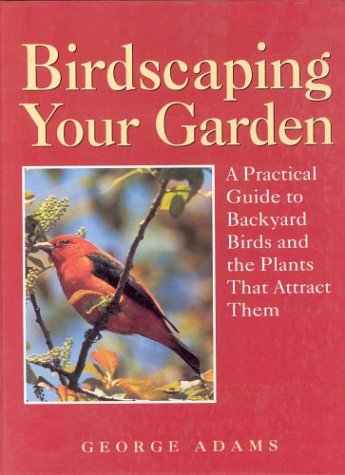The first use of the term “birdscaping” that I can find is in the title of Birdscaping Your Yard, a 47 page pamphlet published by the State of Connecticut Department of Environmental Protection in 1972. The term “birdscaping” is not used in the text itself, where the process of creating wildlife habitat in residential yards is termed wildlife gardening or landscaping. In 1979, Carlin Kindilien wrote a small booklet entitled Natural Birdscaping: How to Attract Birds to Your Yard Naturally.
 In 1994, Rodale Press published Birdscaping Your Garden by George Adams. This 208 page reference work uses the term birdscaping frequently in the text, and also refers to created bird habitats as “birdscapes.”
In 1994, Rodale Press published Birdscaping Your Garden by George Adams. This 208 page reference work uses the term birdscaping frequently in the text, and also refers to created bird habitats as “birdscapes.”
In 2000, Birdscapes was launched as the all bird conservation magazine of the U.S. Fish and Wildlife Service and the Canadian Wildlife Service. The Cornell Lab of Ornithology used Birdscapes as the title of a bird song pop-up book in 2008.
In the past decade, the term birdscaping has become much more common. A Google search in 2004 yielded 835 websites using the term, including sites published by Wildbirds.com, havahart.com, KVFS TV 12 in Cape Girardeau, Missouri, and the Sydney, Australia Birds in Backyards Project. That same search now brings up over 660,000 hits!

While the term birdscapes and birdscaping are fairly new, the concept of landscaping to attract birds has historic roots in European and Middle Eastern bird-bottle and Colonial American birdhouse technologies, the landscape gardening movement in 18th Century England, the bird-preservation studies of Baron von Berlepsch in Germany in the late 1900s, and the popularization of bird feeding, gardening, and landscaping in America during the early 20th Century “Back to Nature” movement.
The strength of birdscaping as a conservation strategy lies in its inherently positive (you can attract and save birds because you like them) rather than negative (birds are being wiped out so we have to do something) approach. In this sense, it transcends the traditional understanding that wildlife management is typically spurred upon realization of declining populations of valued species. It is also a strategy that helps us realize the importance of urban areas as habitat for birds and wildlife.
In short, birdscaping is a positive conservation concept and strategy that appeals to nature-loving homeowners in urban and suburban neighborhoods without resorting to doom-and-gloom rhetoric frequently common in talk about the state of the environment! What’s not to like!?!
